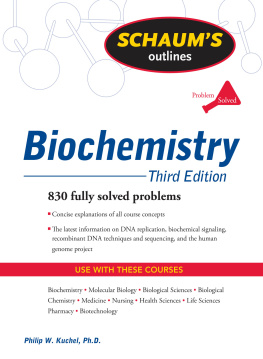CHAPTER 1
Cell Ultrastructure
1.1 Introduction
Question : Since biochemistry is the study of living systems at the level of chemical transformations, it would be wise to have some idea of our domain of study, so we ask, What is life?
There is no universal definition, but most scholars agree that life exhibits the following features:
1. Organization exists in all living systems since they are composed of one or more cells that are the basic units of life.
2. Metabolism decomposes organic matter (digestion and catabolism) and releases energy by converting nonliving material into cell constituents (synthesis).
3. Growth results from a higher rate of synthesis than catabolism. A growing organism increases in size in many of its components.
4. Adaptation is the accommodation of a living organism to its environment. It is fundamental to the process of evolution, and the range of responses of an individual to the environment is determined by its inherited traits.
5. Responses to stimuli take many forms including basic neuronal reflexes through to sophisticated actions that use all the senses.
6. Reproduction is the division of one cell to form two new cells. Clearly this occurs in normal somatic growth, but special significance is attached to the formation of new individuals by sexual or asexual means.
EXAMPLE 1.1 What is the general nature of cells?
All animals, plants, and microorganisms are composed of cells. Cells range in volume from a few attoliters among bacteria to milliliters for the giant nerve cells of squid; typical cells in mammals have diameters of 10 to 100 m and are thus often smaller than the smallest visible particle. They are generally flexible structures with a delimiting membrane that is in a dynamic, undulating state. Different animal and plant tissues contain different types of cells that are distinguished not only by their different structures but also by their different metabolic activities.
EXAMPLE 1.2 Who first saw cells and sparked a revolution in biology by identifying these units as the basis of life?
It was Antonie van Leeuwenhoek (16321723), draper of Delft in Holland, and science hobbyist who ground his own lenses and made simple microscopes that gave magnifications of ~200 . On October 9, 1676, he sent a 17-page letter to the Royal Society of London, in which he described animalcules in various water samples. These small organisms included what are today known as protozoans and bacteria; thus Leeuwenhoek is credited with the first observation of bacteria. Later work of his included the identification of spermatozoa and red blood cells from many species.
There are thousands of different types of molecules in living systems; many of these are discussed in the following pages. As we continue to understand more and more of the intricacies of the regulation of cell function, metabolism, and the structures of macromolecules made by them, it seems natural to ask where the original molecules that made up the first living systems might have come from.
EXAMPLE 1.3 What type of experiments can we carry out that might shed light on the origin of life?
A landmark experiment that was designed to provide some answers to this question was conducted by Stanley Miller and Harold Urey, working at the University of Chicago (see ). Electrical discharges, which simulated lightning, were delivered in a glass vessel that contained water and the gases methane (CH 4), ammonia (NH 3), and hydrogen (H 2), in the same relative proportions that were likely on prebiotic Earth. The discharging went on for a week, and then the contents of the vessel were analyzed chromatographically. The soup that was produced contained almost all the key building blocks of life as we know it today: Miller observed that as much as 1015% of the carbon was in the form of organic compounds. Two percent of the carbon had formed some of the amino acids that are used to make proteins. How the individual molecules might have interacted to form a primitive cell is still a mystery, but at least the building blocks are known to arise under very plausible and readily reproduced physical and chemical conditions.
Fig. 1-1 The Miller-Urey experiment inspired a multitude of further experiments on the origin of life.
In higher organisms, cells with specialized functions are derived from stem cells in a process called differentiation. Stem cells have many of the features of a primitive unicellular amoeba, so in some senses differentiation is like evolution, but it is played out on a much shorter time scale. This takes place most dramatically in the development of a fetus, from the single cell formed by the fusion of one spermatozoon and one ovum to a vast array of different tissues, all in a matter of weeks.
Cells appear to be able to recognize cells of like kind, and thus to unite into coherent organs, principally because of specialized glycoproteins ( ).
1.2 Methods of Studying the Structure and Function of Cells
Light Microscopy
Many cells and, indeed, parts of cells ( organelles) react strongly with colored dyes such that they can be easily distinguished in thinly cut sections of tissue by using light microscopy. Hundreds of different dyes with varying degrees of selectivity for tissue components are used for this type of work, which constitutes the basis of the scientific discipline histology.
EXAMPLE 1.4 In the clinical biochemical assessment of patients, it is common practice to inspect a blood sample under the light microscope, with a view to determining the number of inflammatory white cells present. A thin film of blood is smeared on a glass slide, which is then placed in methanol to fix the cells; this process rigidifies the cells and preserves their shape. The cells are then dyed by the addition of a few drops of each of two dye mixtures; the most commonly used ones are the Romanowsky dyes, named after their nineteenth-century discoverer. The commonly used hematological dyeing procedure is that developed by J. W. Field: A mixture of azure I and methylene blue is first applied to the cells, followed by eosin; all dyes are dissolved in a simple phosphate buffer. The treatment stains nuclei blue, cell cytoplasm pink, and some subcellular organelles either pink or blue. On the basis of different staining patterns, at least five different types of white cells can be identified. Furthermore, intracellular organisms such as the malarial parasite Plasmodium stain blue.
The exact chemical mechanisms of tissue staining are largely poorly understood. This aspect of histology is therefore still empirical. However, certain features of the chemical structure of dyes allow some interpretation of how they achieve their selectivity. They tend to be multiring, heterocyclic, aromatic compounds in which the high degree of bond conjugation gives the bright colors. In many cases they were originally isolated from plants, and they have a net positive or net negative charge.
EXAMPLE 1.5Methylene blue stains cellular nuclei blue.
Mechanism of staining: The positive charge on the N of methylene blue interacts with the anionic oxygen in the phosphate esters of DNA and RNA ( ).
Eosin stains protein-rich regions of cells red.
Mechanism of staining: Eosin is a dianion at pH 7, so it binds electrostatically to protein groups, such as arginyls, histidyls, and lysyls, that have positive charges at this pH. Thus, this dye highlights protein-rich areas of cells.



